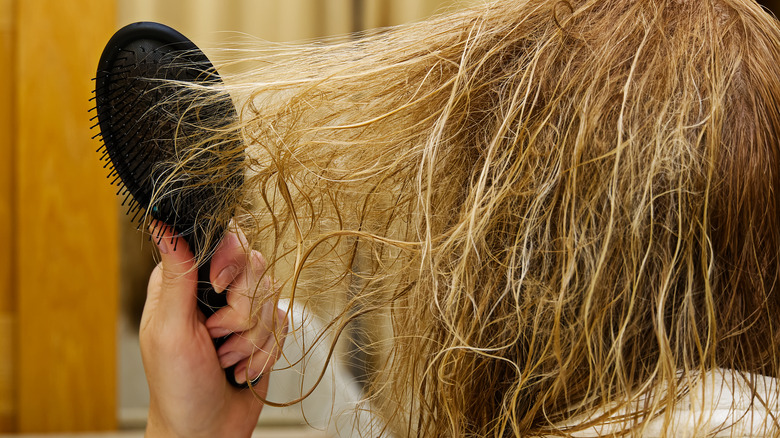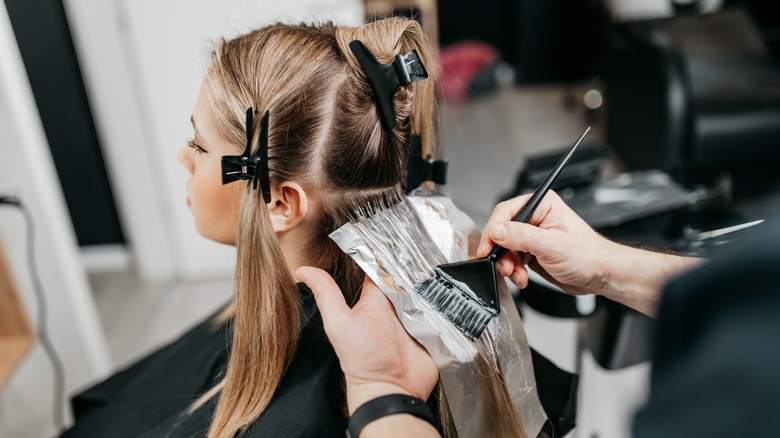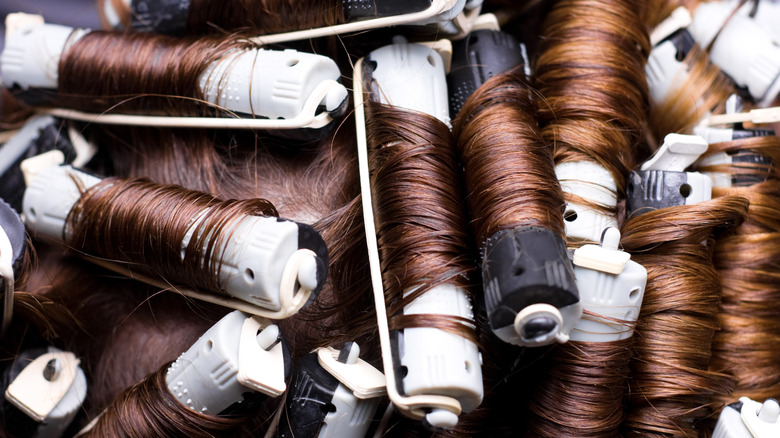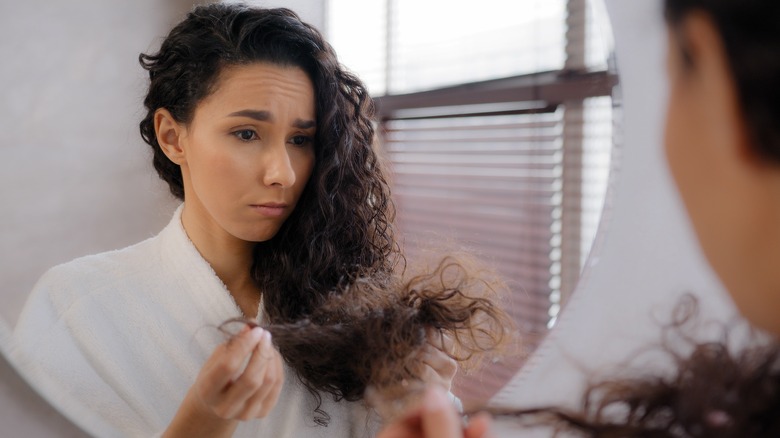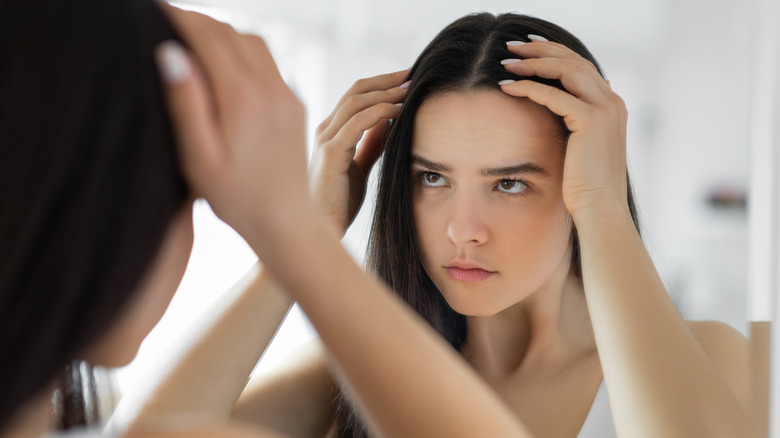How To Prevent The 5 Most Common Types Of Hair Damage
Hair damage: Nobody enjoys it, but pretty much anyone with longer locks has experienced its impact at least once in their life. According to a 2013 survey conducted by Head & Shoulders, 57% of American women said they considered their hair damaged, while 91% of respondents said they do something that could damage their hair almost every day.
Whether you're experiencing tangly split ends, brittle strands from bleach, chemical treatments and heat styling, or increases in hair loss from hormones and stress, damaged locks are one of the most difficult cosmetic issues to treat after the fact. This is because the hair that's growing from our head isn't technically alive (via Healthline). Hair lacks the ability to repair itself or heal like a typical wound, so, because of this, it's best to focus on damage prevention rather than simply trying to repair it once the damage has been done. This doesn't mean that you have to toss your beloved curling iron or forgo your typical coloring treatments entirely, but there are a few things you can do to keep your hair healthy depending on the type of damage you most often face.
Bleach damage
Bleaching your hair, especially routinely, is one of the most damaging treatments you can inflict on your strands. In order to allow bleach to penetrate into the hair shaft and do its work, the cuticle has to be opened, per Philip Kingsley. Repeated treatments can leave your hair's cuticle in this opened state, meaning that it's no longer able to hold on to moisture and is more prone to damage and breakage from other influences. The same goes for most hair dyes — permanent dye needs to open the cuticle and lift the natural color of the hair to create the desired look, so repeated treatments can leave you with a similar level of damage as bleaching.
To prevent this damage, it's obviously best to stop coloring treatments entirely, but, if you're committed to your look, you still have options. First, try going less extreme. All-over platinum blond will likely require multiple initial sessions and frequent follow-up appointments to tackle new growth, but something like a more subtle balayage or highlights is significantly less high maintenance. After dyeing or bleaching, you could also consider incorporating a cuticle-closing conditioner or treatment to lower your hair's porosity and prevent further damage.
Sun and styling damage
The sun's UV rays can dry out your hair over time, causing long-term damage (via Real Simple). And if you have textured hair, you're likely no stranger to heat damage. Constant straightening, blowouts, or curling, especially without a good quality heat protectant, can also leave your hair feeling dry, fried, and prone to additional damage. Thankfully, many modern hair tools have been designed with the goal of preventing damage by ensuring more even and controlled heating, but that doesn't mean that they're completely safe for routine use.
In both the case of sun and styling damage from heat, prevention is the best cure. Apply products with UV protection prior to going out in the sun, especially on hot days. To reduce damage from heat tools, turn down the temperature to the minimum that you need to see results, use a quality heat protectant all over your head, and try to cut back on your frequency of use. For some, this can mean going natural most days of the week and only pulling out your styling tools for special occasions, but for others that still want to stick with their routine, try to work on extending the life of your existing style and going longer between washes. Instead of washing and straightening every day, utilize dry shampoo and slicked-back hairstyles to cut down your styling sessions to once or twice a week.
Damage from chemical treatments
Perms and relaxers may promise less damage as a result of routine heat styling in order to get similar results, but they're far from safe in terms of damage to the hair. Chemical treatments transform the hair by opening the inside of the cuticle, which leaves your hair open to environmental damage, per Huda Beauty. To avoid damage, of course, it's best to avoid undergoing chemical treatments in the first place, but if you do, make sure you're going to a reputable stylist and you allow your hair enough time between visits so you can avoid compounding the damage as much as possible.
Another major tip is to avoid combining chemical treatments with other activities that can cause damage. If your hair is bleached or color-treated, many salons will outright refuse to do an additional chemical service because they don't want to risk putting your hair under that much stress at once. Additionally, avoid using heat or products that dry out your hair, and instead stick with moisturizing, sulfate-free formulas that can help bring back some of that lost moisture.
Breakage
Split ends and breakage are more of a symptom of damage in general than something with a distinct cause, but even if you don't dye, chemically treat, or heat style your hair, you could still be dealing with unwanted damage at the ends. For many, this type of damage is simply the result of time. Because hair doesn't fix itself, minor damage will add up if you go too long between trims, leaving you with splintered ends or even breakage that travels up the hair shaft.
If you're trying to grow out your hair, advice to get regular trims can seem counterintuitive, but it's necessary if you don't want breakage to derail your progress. If you're dealing with splits and breakage in a specific area, it can also be a good idea to take a look at your habits. Try to avoid wearing your hair in tight ponytails or buns, using a brush when wet, sleeping on a rough pillowcase, or doing anything to cause unnecessary friction or tangles.
Hair loss and thinning
Sometimes, when you notice that your hair isn't looking its best, the problem stems from the root, not from damage to the strands themselves. Female hair loss and thinning can be caused by a large number of factors, but stress, hormonal changes, medical conditions, and certain medications are the most common causes. If you know the source of your hair loss, consider talking to a doctor to determine a treatment plan that can help to encourage hair growth and prevent any further issues.
Another common cause of hair loss is pulling from hairstyles like braids, slick ponytails, and tight buns. This is referred to as traction alopecia and more frequently affects women that wear protective braided styles on natural hair, though any race or hair type might see thinning with consistent tight styling (via Healthline). To prevent this or bring your hair back to normal, try out styles that don't consistently pull on the root — most people will see a gradual recovery in their hair's thickness over time.
